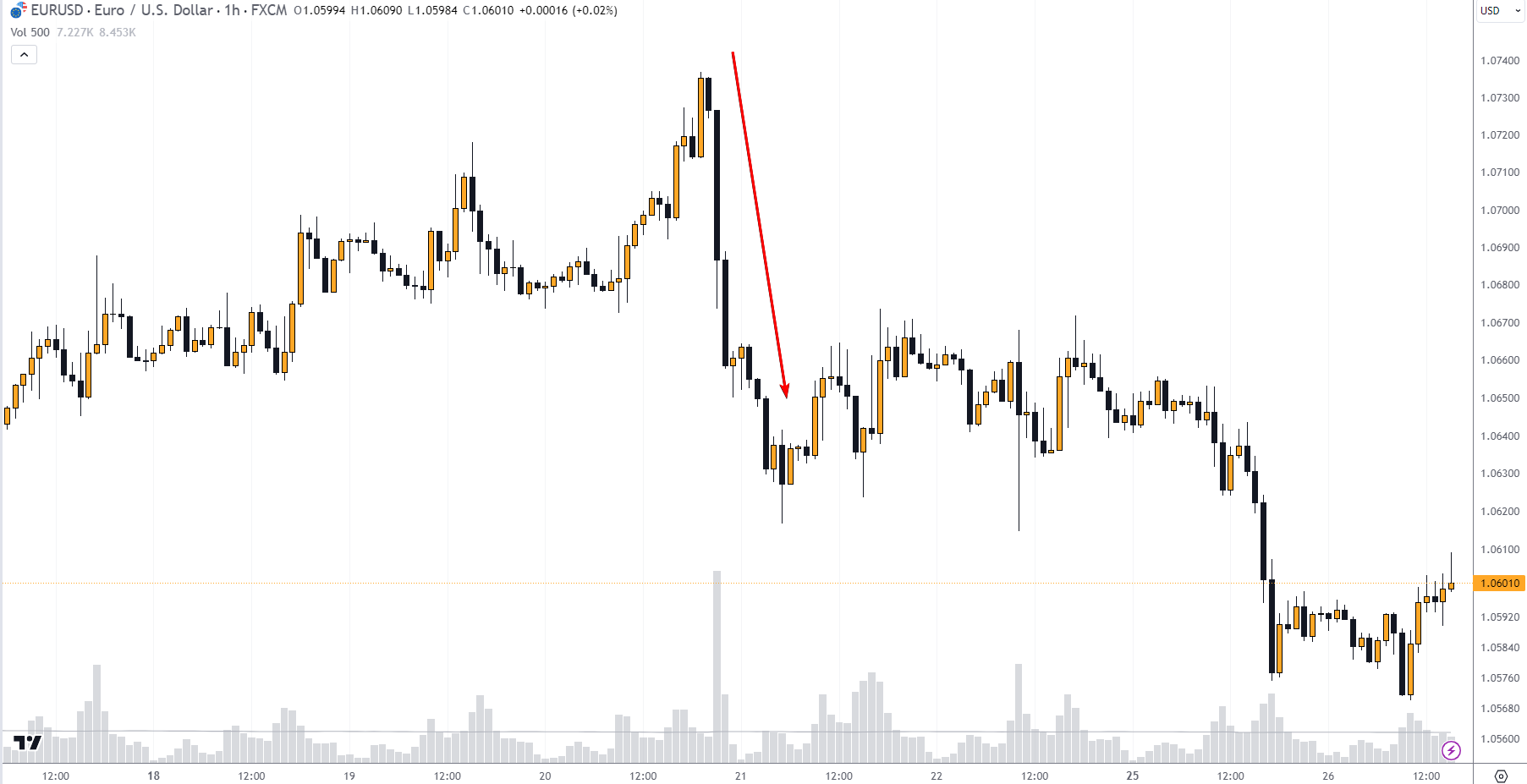7 Risk Management Tips For Those Who Trade On The News
There are following tips to use to manage trading risks:
Using an economic calendar to plan trades;
timing trades carefully by waiting after news releases;
reducing position size to limit risk;
expanding stop loss distances during volatile times;
observing market behavior before news events;
closing positions before weekends;
using diversification and hedging techniques.
Financial markets suffer a spike in trading activity around news releases, which presents possibilities for traders. Nevertheless, many people find themselves on the losing end of this frenzy due to poor risk management. This piece seeks to serve as your reference while you work to reduce the possibility of such expensive mistakes. By employing these tactics, you can more safely and confidently traverse the high-stakes world of news trading, enhancing your chances of attaining positive results while minimizing potential losses.
Basics of risk management
Trading strategies known as “news trading” allow traders to profit on price changes in the financial markets brought on by important news events or the release of economic data. Using this method, trading decisions are based on the anticipated effect of news on asset prices. The volatility that frequently follows news releases is targeted by traders to profit from it, but because market responses to news are unpredictable, a higher risk is involved.
Why is risk management important?
Let’s take an example to understand why risk is important. Let’s say your risk appetite is conservative and are not looking forward to losing your capital at all. In that case, you can’t go for cryptocurrency investing.
This is how risk management looks like if you already have invested in volatile securities, you need to rebalance your portfolio to manage risks of losing capital.
Capital preservation. By preventing catastrophic losses, traders can save their trading capital for potential future opportunities.
Consistency. It allows traders to maintain a steady level of trading performance, lessening the effect of one or two unsuccessful trades on total profitability.
Psychological stability. Risk management eases mental tension and anxiety, enabling traders to make logical choices and adhere to their trading strategies.
Long-term success. Investors who prioritize risk management are more likely to maintain their trading careers and have sustained market success.
For more in-depth insights into Forex risk management strategies, visit the Top Forex Risk Management Strategies page.
Common risks associated with news trading
Making investing decisions based on economic news and events is known as “news trading”, it is a common approach in the financial markets. Although it has the potential to be profitable, there are a few hazards that traders need to be aware of. We will examine some typical hazards connected to news trading in this section.
Increased time to execute a trade
The longer time it takes to execute a trade is one of the prominent threats connected to news trading. A large economic news event, like a central bank interest rate decision or a GDP report, can cause sudden and unpredictably significant price changes in the market. Slippage, in which the actual trade is conducted at a less favorable price than anticipated, might result from this delay in trade execution.
Worsening of the price at which you would like to make a trade
The declining price at which you intend to make a deal is another important risk in news trading. The negative effects of price slippage can force traders to establish positions at prices that are less advantageous than they had originally anticipated. Traders must have well-defined risk management procedures because this could lead to quick paper losses.
Distortion of indicator readings
News announcements may distort technical indications that traders use to make decisions. Price charts may display irregular and exaggerated price fluctuations during high-impact news events, making relying on conventional technical analysis techniques challenging.
Increased volatility
Market volatility often rises in tandem with news trading. While there may be trading opportunities due to this volatility, there are also significant hazards. If traders are unprepared, sudden losses might result from sharp market movements.
7 Tips to help you trade news safely
While trading the news can be profitable, there are hazards involved. News releases can significantly affect market volatility, presenting traders with possibilities and risks. It's essential to use a cautious and knowledgeable approach in order to negotiate this terrain properly.
Here are the top 7 tips to trade safely:
Use economic calendar;
Use timing intelligently to enter a trade;
Reduce the size of the position;
Expand stop loss size;
Watch the market before the news is released;
Reduce or close a position before the weekend;
Use diversification and hedging.
Let’s now understand each of them in detail.
Use an economic calendar
Using an economic calendar is a vital technique for traders aiming to make wise and secure choices in the financial markets. An economic calendar is a web application that lists forthcoming economic activities, such as data releases, meetings of the central bank, and other market-moving developments. It provides essential details, including each event's date, time, significance, historical data, and consensus projections.
With an economic calendar, traders can schedule their plans around significant occasions and prevent unforeseen market volatility and sharp price changes. This planning enables traders to make well-informed decisions, strategically enter or leave positions, and efficiently manage risk. Economic calendars are useful for traders to remain ahead in the fast-paced world. By coordinating their activities with anticipated economic changes, traders can trade news events profitably and safely.
To access a reliable economic calendar, visit TradersUnion's Economic Calendar.
Use timing intelligently
For traders trying to traverse the challenging waters of news trading successfully, “Use Timing Intelligently” is a critical tactic. Following a large news release, this strategy calls for patience and caution. Trading professionals wait for a window of opportunity, often lasting 5 to 20 minutes, before making a transaction to assess the market's initial reaction.
It is beneficial due to various reasons.
First, it gives the market time to settle after the initial reaction, preventing traders from being trapped in wild price fluctuations.
Second, it offers a chance to evaluate the general market mood and spot prospective trends. Traders can make better decisions, better manage risk, and better position themselves for more advantageous entry positions by waiting for this brief interval.
Essentially, “Using Timing Intelligently” is about being composed in the face of market upheaval and choosing reasoned actions over emotional ones.
Reduce position size
Reducing position size is an essential risk management tactic when trading news events. You must trade fewer contracts or shares in a given position to do this. This strategy limits potential losses during increased volatility brought on by news releases.
By lowering the size of the positions, traders can safeguard their trading funds from substantial, unforeseen price movements that frequently occur when important news is released. A smaller trade size results in a proportionally smaller loss if the market swings against your position, protecting more of your capital.
Risk management method is especially pertinent for traders who wish to take advantage of news-related opportunities while controlling their exposure to anticipated market turmoil.
Expand stop loss size
When trading news events, increasing the size of your stop loss is an essential risk management tactic. It's crucial to safeguard your capital from unanticipated negative swings because news releases frequently cause abrupt and significant market fluctuations. You can give the market some breathing room without prematurely triggering your stop loss by increasing the distance between your entry point and stop loss.
The goal is to ensure that your stop loss is placed at a level where it can survive the heightened volatility from news releases. Setting your stop loss too far away might expose your account to greater potential losses; therefore, it's crucial to strike a balance. To maintain efficient risk management, traders typically strive to keep their highest probable loss between 2-3% of their trading capital. Increasing the magnitude of your stop loss is a proactive step you may take to protect your investments in these erratic market conditions.
Learn more about using stop loss orders effectively by visiting TradersUnion's Research Stop-loss order: should I use?
Watch the market before news releases
It is wise to monitor how the market reacts before a big news release to see how it will move. This activity is beneficial since it gives knowledge of other dealers' attitudes and expectations. Frequently, just before the news is announced, you'll observe that the market makes strange swings in the other way. This is linked to traders placing irrational, speculative wagers before the news release.
You can learn important information about the potential direction of the market after an announcement by keeping an eye on these pre-news market movements. The market may be already priced into the consensus, or traders may expect a different conclusion if it moves against the predicted news outcome. This knowledge may enable you to make more informed choices and prevent needless losses when trading news events.

Example of the "buy the rumor, sell the fact" phenomenon
The market's actions during Powell's press conference, shown by the arrow in the previously described figure, are an excellent example of the "buy the rumor, sell the fact" phenomenon. Before the news, prices rose in expectation, but the subsequent decline implies that the market has already factored in the anticipated information, resulting in a post-announcement correction.
Reduce or close positions before the weekend
To protect their investments, traders use risk management to reduce or cancel positions before the weekend. These unanticipated events could cause big price gaps and significant losses when the market reopens on Monday.
Traders try to eliminate exposure to these weekend gaps and lower risk by lowering their positions' size or closing them before the weekend. It's a preventative technique to stop unfavorable market changes from eroding profits or unanticipated losses. It may limit possible gains if the market moves in your favor over the weekend, but it puts capital preservation and risk management first—two key elements of successful trading.
Use diversification and hedging
Diversification entails distributing your investments over a range of asset classes or instruments to lower risk. Diversifying your holdings helps reduce the impact of unfavorable developments when you trade news. You reduce the possibility that a single news event may materially hurt your whole portfolio by maintaining investments in various assets.
On the other side, hedging is a tactic that entails adopting opposing positions to reduce prospective losses. Hedging can be done for news trading utilizing derivatives, correlated assets, or options. For instance, you can utilize options to create a defensive position in the other direction if you hold a long position on a currency pair and you expect a turbulent news release. This minimizes your overall risk exposure by offsetting any negative price movement with gains in the hedging position.
Conclusion
Using poor risk management techniques might have serious repercussions. Failure to abide by these guidelines has risks, such as the possibility of catastrophic losses that might completely deplete your trading capital, emotional anguish that impairs judgment, and a curtailed trading career. You expose yourself to the volatile and unpredictable character of the financial markets during news events if you don't practice risk management.
Remember to safeguard your money and continue participating in the market to succeed in news trading. Because risk management is the armor that protects against uncertainty and volatility, make it your loyal companion on your trip to trading riches.
Best Forex brokers 2024


FAQs
What is risk management in trading?
Trading risk management includes methods and strategies to reduce possible losses and safeguard cash. It seeks to maximize profits while ensuring traders can withstand challenging market circumstances.
What does “buy the rumor, sell the fact” mean?
A trading method known as "buy the rumor, sell the fact" involves making market predictions before upcoming news or occurrences. They invest in assets based on rumors, sell them when the news or event happens, and frequently cause price reversals.
How do you analyze news for trading?
Assessing the possible effect of news events on financial markets is part of news analysis for trading. This entails assessing the event's significance, general predictions, and prior information and analyzing how it might influence asset prices.
How do you know the market direction before a news release?
It can be difficult to forecast market direction before a news release, but you can try to do so by tracking pre-news price movements, doing sentiment research, and considering how the market has historically reacted to comparable news events.
Glossary for novice traders
-
1
Broker
A broker is a legal entity or individual that performs as an intermediary when making trades in the financial markets. Private investors cannot trade without a broker, since only brokers can execute trades on the exchanges.
-
2
Trading
Trading involves the act of buying and selling financial assets like stocks, currencies, or commodities with the intention of profiting from market price fluctuations. Traders employ various strategies, analysis techniques, and risk management practices to make informed decisions and optimize their chances of success in the financial markets.
-
3
Risk Management
Risk management is a risk management model that involves controlling potential losses while maximizing profits. The main risk management tools are stop loss, take profit, calculation of position volume taking into account leverage and pip value.
-
4
Volatility
Volatility refers to the degree of variation or fluctuation in the price or value of a financial asset, such as stocks, bonds, or cryptocurrencies, over a period of time. Higher volatility indicates that an asset's price is experiencing more significant and rapid price swings, while lower volatility suggests relatively stable and gradual price movements.
-
5
Diversification
Diversification is an investment strategy that involves spreading investments across different asset classes, industries, and geographic regions to reduce overall risk.
Team that worked on the article
Upendra Goswami is a full-time digital content creator, marketer, and active investor. As a creator, he loves writing about online trading, blockchain, cryptocurrency, and stock trading.
Dr. BJ Johnson is a PhD in English Language and an editor with over 15 years of experience. He earned his degree in English Language in the U.S and the UK. In 2020, Dr. Johnson joined the Traders Union team. Since then, he has created over 100 exclusive articles and edited over 300 articles of other authors.
Mirjan Hipolito is a journalist and news editor at Traders Union. She is an expert crypto writer with five years of experience in the financial markets. Her specialties are daily market news, price predictions, and Initial Coin Offerings (ICO).









